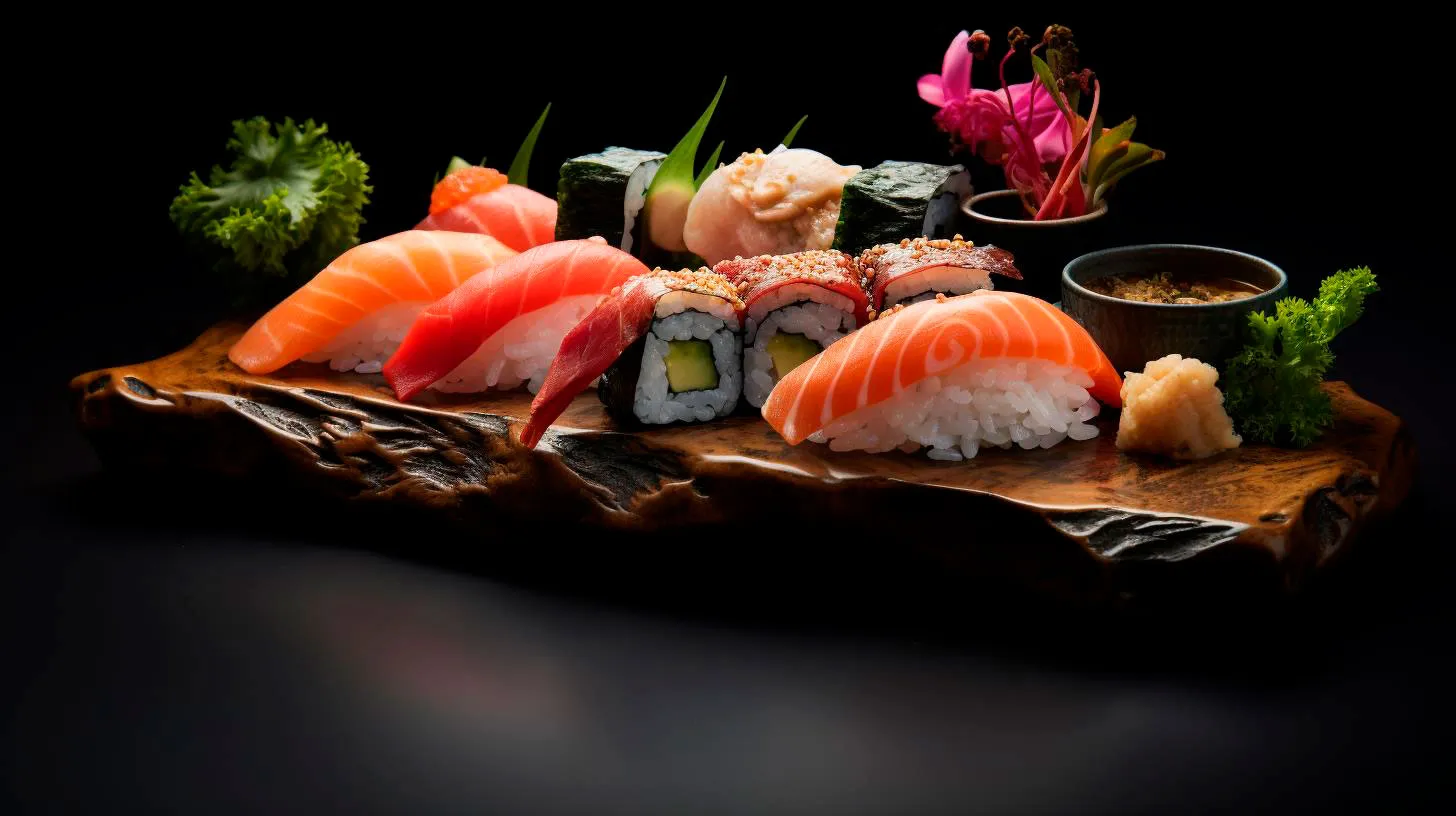Transforming Sushi Rice Incorporating Fusion Flavors
In this article, we will explore the concept of transforming sushi rice by incorporating fusion flavors, and how it has revolutionized the culinary world.
The Basics of Sushi Rice
Sushi rice is at the heart of every sushi roll. It is made using a specific variety of short-grain rice called Japonica rice, which becomes sticky when cooked. The rice is seasoned with a mixture of rice vinegar, sugar, and salt, called sushi vinegar, to add flavor. Traditionally, sushi rice has a subtle and slightly tangy taste that complements the flavors of the fillings and toppings used in sushi rolls.
However, with fusion flavors becoming more popular, chefs are now experimenting with different ingredients and seasonings to give sushi rice an exciting twist. Let’s delve into some creative ways sushi rice has been transformed, incorporating flavors from various culinary traditions:
1. Spicy and Tangy Sushi Rice
Sushi rolls are no stranger to spice, thanks to popular rolls like the spicy tuna roll. But chefs are taking it a step further by introducing spicy and tangy flavors directly into the sushi rice. By adding ingredients like spicy mayo, gochujang (Korean chili paste), or even hot sauce to the sushi vinegar mixture, they create a vibrant and zesty flavor profile. This fusion twist adds an extra kick to traditional sushi rolls and enhances the overall taste experience.
Key Takeaway: Transforming sushi rice with spicy and tangy flavors brings a new level of excitement to traditional sushi rolls. It adds a bold and zippy taste that can please adventurous palates.
2. Teriyaki-Glazed Sushi Rice
Teriyaki sauce is a staple in Japanese cuisine, known for its rich and savory flavor. By glazing sushi rice with teriyaki sauce, chefs infuse it with an umami-packed taste that perfectly complements the fillings within the sushi roll. This fusion-inspired combination showcases the versatility of sushi rice and allows for a delightful blend of traditional Japanese flavors with a modern twist.
Key Takeaway: Teriyaki-glazed sushi rice adds depth and richness to sushi rolls, creating a harmonious balance of flavors. The umami-packed taste elevates the overall sushi experience.
3. Thai-Inspired Sushi Rice
The vibrant and aromatic flavors of Thai cuisine offer an excellent opportunity for fusion experimentation. Chefs have started incorporating Thai ingredients like lemongrass, coconut milk, and Thai chili into sushi rice. This fusion-style sushi rice adds a refreshing and exotic element to the rolls, taking taste buds on a culinary journey to Southeast Asia.
Key Takeaway: Thai-inspired sushi rice brings a burst of refreshing flavors, infusing sushi rolls with the essence of Thai cuisine. It offers a unique and delightful sushi experience for those who enjoy exploring new taste sensations.
The Future of Fusion Flavored Sushi Rice
As the popularity of fusion cuisine continues to grow, so does the potential for creativity and innovation with sushi rice. Chefs are constantly pushing the boundaries and experimenting with different flavors and ingredients from around the world. This experimentation not only appeals to adventurous eaters but also attracts a new audience to the world of sushi.
According to industry statistics, the global sushi market is projected to reach a value of $22.3 billion by 2025, with the United States being one of the largest consumers of sushi. This presents a significant opportunity for chefs to showcase their fusion-flavored sushi rice creations and cater to the evolving tastes and preferences of consumers.
In conclusion, transforming sushi rice by incorporating fusion flavors has revolutionized the sushi industry. By embracing the concept of fusion cuisine, chefs have elevated sushi rolls to new heights, creating a delightful fusion of flavors that appeal to a wide range of taste preferences. Whether it’s the spicy and tangy twist, the umami-packed teriyaki glaze, or the refreshing Thai infusion, each fusion-inspired sushi rice adds a unique dimension to the sushi experience. So, the next time you visit a sushi restaurant, be sure to explore the exciting world of fusion-flavored sushi rice!
Unleashing Your Creativity: Unique Sushi Rice Recipes
By getting creative with sushi rice, you can unlock a world of possibilities that will delight your taste buds and impress your guests. In this article, we will dive into some extraordinary sushi rice recipes that are sure to tantalize your senses and take your culinary skills to new heights.
1. Spicy Tuna and Avocado Sushi Burrito
This fusion of Japanese and Mexican cuisine is a match made in gastronomic heaven. Instead of using traditional nori wraps, this recipe utilizes a layer of sushi rice, creating a sushi burrito that is packed with flavor and easy to eat. Here’s how you can make it:
- Mix spicy mayo and diced raw tuna in a bowl.
- Spread sushi rice evenly on a sheet of plastic wrap, leaving room at the edges.
- Place sliced avocado, cucumber, and the spicy tuna mixture on top of the rice.
- Slowly roll the plastic wrap, using it to shape the ingredients into a burrito shape.
- Unwrap the plastic and enjoy your delicious sushi burrito.
This unique twist on sushi is not only visually appealing but also a convenient option for on-the-go meals. It’s perfect for lunchboxes or picnics, and you can customize the fillings according to your taste preferences.
2. Crispy Tempura Shrimp Sushi Roll
If you’re a fan of the crispy texture of tempura, this sushi roll will surely hit the spot. By incorporating tempura-battered shrimp into your sushi roll, you add a delightful crunch to each bite. Here’s how you can prepare it:
- Dip large shrimp in tempura batter and deep-fry until golden brown.
- Spread sushi rice on a sheet of nori.
- Place the tempura shrimp, cucumber slices, and avocado on top of the rice.
- Roll the sushi tightly and cut into bite-sized pieces.
- Serve with soy sauce and enjoy the contrasting textures of crispy tempura and tender rice.
This sushi roll variation combines the best of both worlds, offering the essence of traditional sushi with an added twist of crunchiness.
3. Mango and Cream Cheese Inside-Out Sushi Roll
If you crave a hint of sweetness in your sushi, this mango and cream cheese inside-out roll is a must-try. The combination of tangy cream cheese and luscious mango slices adds a burst of tropical flavors. Here’s how to make it:
- Spread sushi rice evenly on a sheet of plastic wrap.
- Place a layer of plastic wrap on top of the rice and flip it over.
- Spread cream cheese and thin slices of ripe mango on the nori sheet.
- Roll the sushi tightly and cut into bite-sized pieces.
- Garnish with sesame seeds and drizzle with a sweet and spicy sauce.
The combination of creaminess from the cheese and the freshness of mango creates a delightful contrast that will surely leave your taste buds wanting more.
Key Takeaways
By experimenting with unique sushi rice recipes, you can elevate your dining experience and impress your guests with your culinary skills. Here are the key takeaways from this article:
- Spice up your sushi game by trying different combinations of ingredients.
- Get creative with sushi burritos for a convenient and customizable meal.
- Add crispy tempura shrimp for a delightful crunch in your sushi rolls.
- Explore sweet and savory combinations like mango and cream cheese for a unique twist on traditional sushi.
- Personalize your sushi creations with garnishes and sauces to enhance their visual appeal.
Remember, sushi is a canvas waiting for your creativity. Don’t be afraid to experiment, mix flavors, and unleash your inner sushi chef. Bon appétit!
Exploring Different Varieties of Sushi Rice
Without the right sushi rice, the entire dish falls flat. In this article, we will delve into the different varieties of sushi rice, exploring their unique characteristics and how they contribute to the overall taste and texture of sushi.
Understanding the Importance of Sushi Rice
Before we dive into the different varieties of sushi rice, let’s understand why this particular component is so crucial. Sushi rice serves as the base of every sushi roll, providing a soft and slightly sticky texture that allows the other ingredients to adhere together. Its subtle sweetness and vinegary flavor help to enhance the taste of the fish or vegetables, creating a harmonious balance of flavors in each bite.
When it comes to sushi rice, there are several varieties available, each with its own unique characteristics and origins. Let’s explore some of the most popular ones:
1. Koshihikari Rice
- Koshihikari rice is considered the king of sushi rice in Japan.
- It is known for its exceptional taste, fragrance, and texture.
- Revered for its pure white color and glossy appearance.
- Highly valued for its ability to absorb flavors and maintain its shape.
2. Calrose Rice
- Calrose rice is a medium-grain rice that originated in California.
- It is commonly used in sushi and other Asian dishes.
- Known for its slightly sticky texture and mild flavor.
- Provides a good balance between stickiness and ease of rolling.
3. Sasanishiki Rice
- Sasanishiki rice is a popular sushi rice variety from Niigata, Japan.
- It has a delicate texture and a subtle sweetness.
- Preferred by sushi chefs for its excellent moisture retention.
- Prized for its ability to showcase the flavors of raw fish.
Choosing the Perfect Sushi Rice
With several varieties of sushi rice to choose from, how do you select the perfect one for your sushi rolls? Here are some key considerations:
- Stickiness: Depending on your preference, you may want a rice variety that is stickier or less sticky.
- Flavor: Different sushi rice varieties have distinct flavors ranging from mild to fragrant.
- Texture: Consider the texture you desire in your sushi rice – whether soft and tender or slightly firm.
- Origin: Some rice varieties, such as Koshihikari, hold greater prestige due to their origin and reputation.
Ultimately, it’s a matter of personal preference and the type of sushi you intend to make. Try experimenting with different varieties to find the one that suits your taste buds and desired sushi experience.
Key Takeaways
Sushi rice is the essential component that holds every sushi roll together. Understanding the different varieties of sushi rice can help elevate your sushi-making skills and enhance the overall dining experience. Here are the key takeaways to remember:
- Choose a sushi rice variety based on stickiness, flavor, texture, and origin.
- Koshihikari rice is highly revered for its taste, fragrance, and texture.
- Calrose rice offers a good balance between stickiness and ease of rolling.
- Sasanishiki rice is known for its delicate texture and moisture retention qualities.
By exploring and experimenting with different varieties of sushi rice, you can create sushi rolls that not only look beautiful but also taste exceptional. So, next time you embark on a sushi-making adventure, remember that your choice of rice plays a vital role in shaping the final outcome of this culinary delicacy.
Enhancing Your Sushi Rice with Traditional Japanese Methods
In this blog post, we will explore traditional Japanese methods of enhancing sushi rice to elevate your sushi game.
The Importance of Properly Cooked Sushi Rice
Creating the perfect sushi roll begins with perfectly cooked sushi rice. The rice should have a sticky texture that holds together when combined with the other ingredients. Achieving this requires attention to detail and following specific techniques that originated in Japan.
Key Takeaway: Properly cooked sushi rice is the foundation of outstanding sushi rolls.
Washing the Rice
Before cooking sushi rice, it’s crucial to wash it thoroughly. Washing rice removes excess starch and impurities, resulting in fluffier and tastier rice. In Japan, the preferred method of washing rice involves gently rubbing the grains together under cold running water until the water runs clear.
- Washing rice improves the texture and taste of the sushi rice.
- Gently rubbing the rice grains removes excess starch and impurities.
- Removing impurities enhances the flavor and appearance of the cooked rice.
Proper Cooking Techniques
Cooking sushi rice requires precision and careful attention to detail. Traditional Japanese sushi chefs follow a specific cooking method to ensure the rice is perfectly cooked.
- Use a heavy-bottomed pot with a tight-fitting lid to cook sushi rice.
- Always follow the recommended rice-to-water ratio for best results.
- Allow the rice to rest undisturbed for a few minutes after cooking to achieve the ideal texture.
By adhering to these traditional Japanese cooking techniques, you can achieve sushi rice that is tender, sticky, and full of flavor.
The Role of Sushi Vinegar
Sushi vinegar, a mixture of rice vinegar, sugar, and salt, is an essential ingredient in sushi rice. It not only adds flavor but also plays a crucial role in preserving the rice and preventing bacterial growth. In Japan, sushi vinegar is added to the cooked rice while gently folding it with a wooden spatula.
- Sushi vinegar enhances the flavor profile of the sushi rice.
- The acidic properties of rice vinegar help prolong the shelf life of the rice.
- Gently folding the rice with sushi vinegar ensures even distribution of flavor.
The Art of Sushi Rice Seasoning
Seasoning sushi rice requires a delicate balance of flavors. Traditional Japanese sushi chefs achieve this by adding just the right amount of sushi vinegar while allowing the rice to cool to room temperature. This process allows the flavors to meld together, resulting in perfectly seasoned sushi rice.
- Adding the correct amount of sushi vinegar enhances the taste of the sushi rice.
- Cooling the rice to room temperature helps develop the flavors.
- Proper seasoning enhances the overall sushi roll experience.
Conclusion
Mastering the art of sushi making involves paying attention to every detail, and that includes the sushi rice. By following the traditional Japanese methods we discussed, you can enhance your sushi rice and elevate your sushi rolls to a whole new level. Remember, properly cooked and seasoned sushi rice is the key to a memorable sushi experience.
So, the next time you enjoy sushi, take a moment to appreciate the effort put into creating the perfect sushi rice. Your taste buds will thank you.



